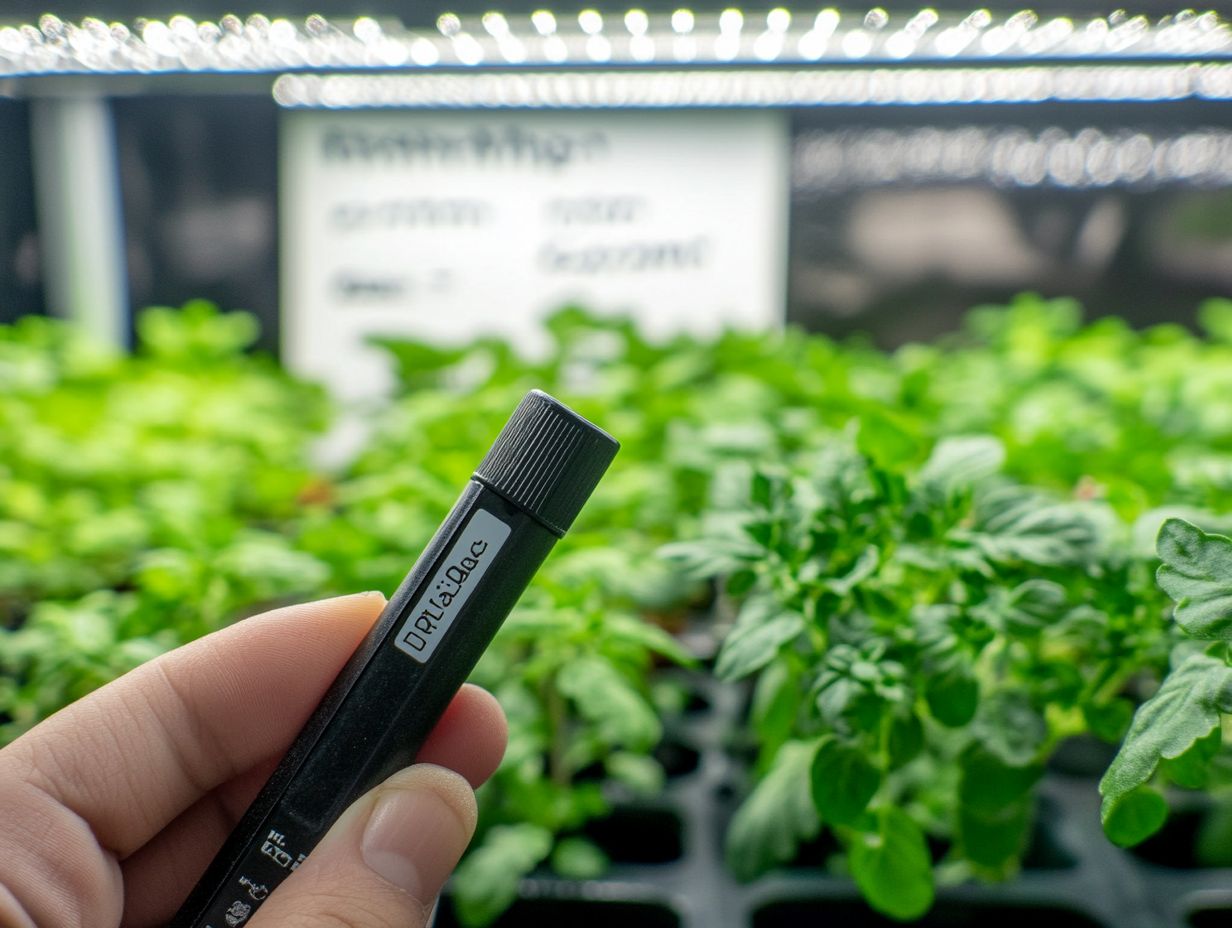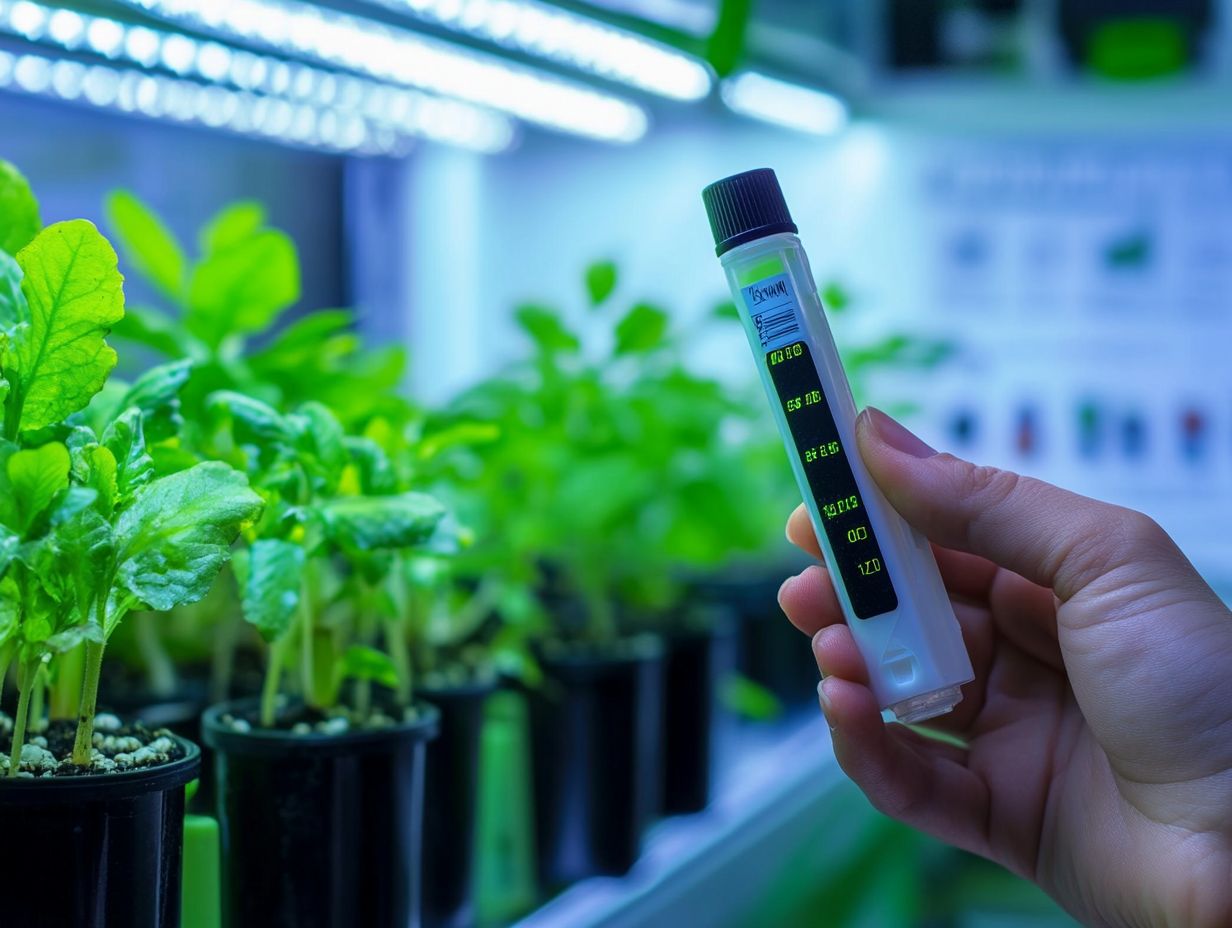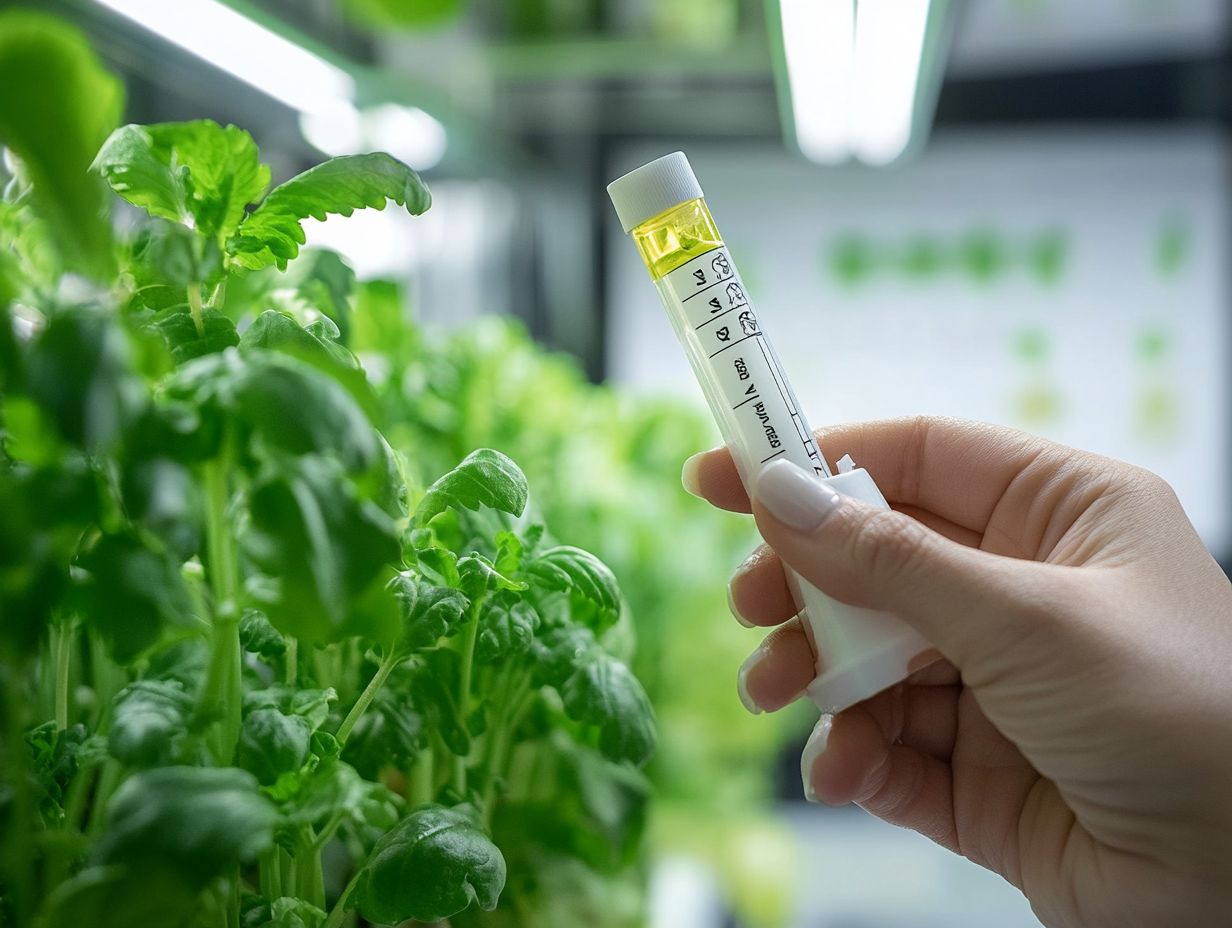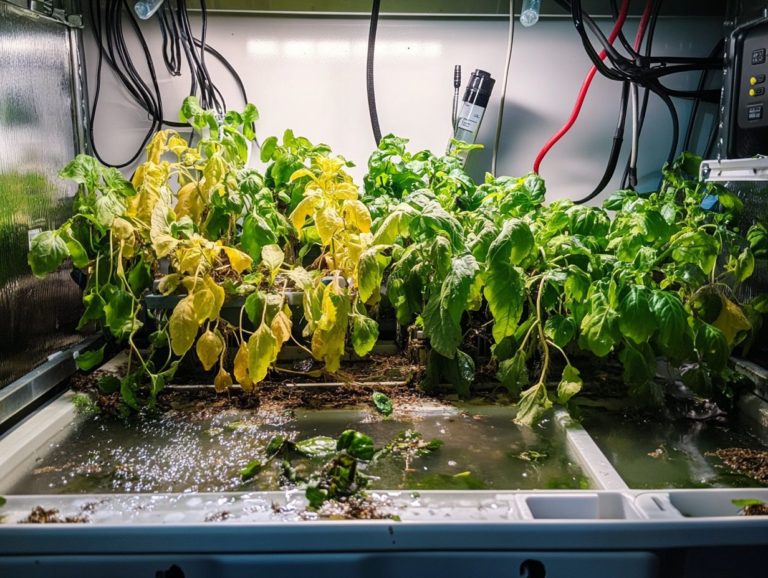5 Quick Fixes for Hydroponic Problems
Hydroponic gardening introduces an innovative method for cultivating plants without soil, yet it presents unique challenges.
Whether you re a seasoned grower or just starting your journey, understanding common mistakes is vital for success. Get ready to discover five common hydroponic problems that could be holding you back spanning pH level imbalances to overcrowding and learn practical solutions to keep your system thriving.
You ll uncover best practices for maintaining nutrient balance and optimal lighting, along with effective strategies to combat pests and diseases. Dive in to ensure your hydroponic garden flourishes!
Contents
- Key Takeaways:
- 1. pH Level Imbalance
- 2. Nutrient Deficiencies
- 3. Improper Lighting
- 4. Pests and Diseases
- 5. Overcrowding of Plants
- How to Prevent and Fix These Common Hydroponic Problems
- What Are the Best Practices for Maintaining pH Levels in a Hydroponic System?
- How Can Nutrient Deficiencies Be Identified and Corrected?
- What Type of Lighting Is Best for Hydroponic Systems?
- How Can Pests and Diseases Be Prevented and Treated in Hydroponic Gardens?
- What Is the Ideal Plant Density for a Hydroponic System?
- Frequently Asked Questions
- What are the common hydroponic problems that can be solved with 5 quick fixes?
- How can I fix a pH imbalance in my hydroponic system?
- What should I do if my plants show signs of nutrient deficiency?
- How can I get rid of pests in my hydroponic system?
- What can I do to prevent algae growth in my hydroponic system?
- How do I fix a clogged irrigation system in my hydroponic setup?
Key Takeaways:

- Maintain proper pH levels to ensure healthy plant growth. Test and adjust levels regularly to prevent imbalances.
- Identify and correct nutrient deficiencies by closely monitoring plant growth and providing appropriate nutrients.
- Select the right type of lighting for your hydroponic system to promote optimal plant growth.
1. pH Level Imbalance
Maintaining the correct pH level in your hydroponic system is crucial for your plants health. Even the slightest imbalance can cause significant issues, including nutrient deficiencies, root rot, and various plant diseases, ultimately jeopardizing your crop yield and the success of your hydroponic gardening efforts.
Understanding the importance of pH levels in soil-less gardening can greatly enhance your experience. To accurately measure pH, using tools such as pH test strips or electronic meters is essential, as they provide quick insights into the acidity or alkalinity of your nutrient solution.
The ideal pH range varies, with most plants thriving between 5.5 and 6.5, while some vegetables may prefer different levels. When adjustments are necessary, consider adding vinegar to increase acidity or baking soda to boost alkalinity. Remember, applying these DIY methods with care is key to preventing sudden pH swings.
If you notice signs of distress in your plants like yellowing leaves or stunted growth checking the pH should be your first step. This simple action often uncovers underlying issues affecting nutrient uptake, guiding you toward a solution.
2. Nutrient Deficiencies
Identifying and correcting nutrient deficiencies in hydroponic gardening is essential because a lack of crucial nutrients can lead to severe health issues, stunted growth, and reduced crop yield. This highlights the importance of a balanced nutrient solution tailored specifically for your plants.
By recognizing the distinct signs of deficiencies, you can take timely action. For instance, yellowing leaves may indicate a nitrogen deficiency, while purple tinges could suggest a lack of phosphorus.
With this information, you can effectively utilize hydroponic nutrients to amend any deficiencies. Regularly monitor your nutrient solution’s pH and electrical conductivity (a measure of nutrient concentration) to enhance nutrient availability and uptake, ensuring an optimal growing environment. Be mindful of hydroponic nutrient burn to prevent any potential issues.
Employ foliar sprays to provide a quick remedy for immediate nutrient needs, while adjusting the nutrient mix helps prevent future occurrences. By consistently evaluating your hydroponic system, you maintain fertile conditions that encourage your plants to thrive.
3. Improper Lighting
Improper lighting can harm your plants. It can affect their health and yield.
To truly optimize growth, utilizing LED lights is key. LEDs are particularly energy-efficient and provide targeted light spectrums that can boost photosynthesis, fostering robust plant development.
On the other hand, fluorescent lights tend to be more budget-friendly and can be placed closer to your plants without the risk of burning them. It s crucial to deliver the right light spectrum blue light encourages vegetative growth, while red light promotes flowering.
Positioning these lights 12-24 inches above your plants and ensuring a consistent exposure duration of 14-20 hours daily can create a remarkable impact. Keep an eye out for signs of distress, such as yellowing leaves or elongated stems, which may indicate inadequate light.
4. Pests and Diseases

Pests and diseases can threaten your hydroponic garden. It’s vital to have effective control strategies for vibrant plant health.
Common challenges such as aphids, whiteflies, and powdery mildew can swiftly disrupt the balance of your hydroponic system. These pests drain nutrients needed for growth and can carry diseases that devastate entire crops. To address related issues, learn how to fix nutrient deficiencies in hydroponics.
To tackle these challenges, embracing preventive techniques is crucial. Using beneficial insects, like ladybugs and predatory mites, can naturally reduce pest populations. You can also incorporate organic gardening methods such as crop rotation and companion planting to further mitigate infestations.
For immediate solutions, Safer Brand products provide effective treatments aligned with organic practices. You can also try DIY remedies like soapy water sprays or Neem oil solutions; these can be powerful allies in your integrated pest management strategy.
5. Overcrowding of Plants
Overcrowding your plants can seriously hinder their growth. It leads to poor air circulation and fierce competition for nutrients.
Understanding plant density is crucial for success. The ideal spacing varies by crop; for example, leafy greens like lettuce thrive when spaced 6-8 inches apart, while larger plants like tomatoes need 24-30 inches between them.
When plants are crammed together, they struggle to access essential resources. This makes them vulnerable to root rot and diseases that can spread quickly in tight quarters.
To effectively manage space in smaller setups, consider techniques like vertical farming and regular pruning. These strategies help reduce overcrowding, allowing each plant the room it needs to thrive.
How to Prevent and Fix These Common Hydroponic Problems
Preventing and resolving common hydroponic issues demands a proactive mindset. It s about developing strategies that prioritize plant health and having quick fixes for challenges like nutrient deficiencies, pests, and lighting problems.
To cultivate optimal growth, regularly monitor water quality to ensure it meets the needs of your crops. This involves checking pH levels and adjusting nutrient solutions, as even minor imbalances can lead to setbacks.
Being prepared with backup supplies can make a difference when unexpected challenges arise. You can use household items to create temporary fixes for equipment failures or pest barriers until a more permanent solution is available.
What Are the Best Practices for Maintaining pH Levels in a Hydroponic System?
Stable pH levels are crucial for healthy plants in your hydroponic system. Sudden fluctuations can lead to nutrient absorption issues, which seriously hinder growth and crop yield.
To navigate this challenge, establish a routine of regular pH testing. Aim for every few days to keep tabs on changes and maintain stability. Using pH adjusters can streamline this process, enabling timely corrections when your readings stray from the ideal range for your specific crops. Additionally, it’s helpful to know how to troubleshoot common hydroponic issues to ensure your system runs smoothly.
Different plant species have unique pH preferences. Understanding these requirements is key to your success. If you notice issues like yellowing leaves or stunted growth, act quickly! Check the pH levels in hydroponic gardens if you notice any problems. Making adjustments to bring the pH back to the desired level can often revive your plants, underscoring the importance of proactive management in your hydroponic journey.
How Can Nutrient Deficiencies Be Identified and Corrected?

Identifying and correcting nutrient deficiencies in hydroponic systems is crucial for maintaining your plants’ health and achieving optimal growth. Symptoms can vary significantly depending on which nutrient is lacking.
Look for signs like yellowing leaves, stunted growth, or poor flowering; these can be critical clues. Start with a close examination of your plants and their growing environment. By observing these visible symptoms and testing the nutrient solution for key elements like nitrogen, potassium, or calcium, you can accurately diagnose deficiencies. Additionally, you can refer to our guide on identifying common hydroponic system issues for more insights.
Once you’ve pinpointed the issue, it’s time to administer the right hydroponic nutrients. This could mean using pre-mixed solutions or crafting customized blends tailored to your plants’ specific needs. For best results, consider following these 7 tips for successful hydroponic gardening.
Prevent future deficiencies by regularly monitoring pH and electrical conductivity. Also, maintaining a balanced nutrient profile is essential. Don’t underestimate the importance of ensuring proper light and air circulation; these factors help minimize the risk of nutrient stress. If you encounter issues, refer to this guide on how to troubleshoot hydroponic system failures to keep your plants thriving.
What Type of Lighting Is Best for Hydroponic Systems?
The type of lighting you choose for your hydroponic system is pivotal for plant health and can significantly impact your crop yield. Selecting the right kind of lighting tailored to your plants’ specific needs is essential.
You have various options like LED, fluorescent, and HID lights, each with its advantages and drawbacks. LEDs are celebrated for their energy efficiency, longevity, and ability to produce specific light spectrums suited for different growth stages, from germination to flowering. Fluorescent lights can be cost-effective for smaller setups, though you might need to replace them more frequently than LEDs.
HID lights deliver high intensity and penetration, making them ideal for larger setups. However, they generate more heat and use more electricity. Each type of lighting interacts uniquely with plant growth stages, emphasizing the need to understand their distinct qualities.
Regarding installation, careful planning is key to avoiding light burn while ensuring optimal coverage. Regular maintenance checks, such as bulb replacements, fixture cleaning, and following 5 tips for maintaining your hydroponic setup, are vital to maintaining efficacy and safeguarding both plant health and yields throughout the growing cycle.
How Can Pests and Diseases Be Prevented and Treated in Hydroponic Gardens?
Preventing and treating pests and diseases in your hydroponic garden is crucial for maintaining plant health. Infestations can spread rapidly and wreak havoc on your crops if not addressed promptly and effectively.
By implementing a combination of preventive strategies like regular inspections and the use of physical barriers you can significantly reduce the likelihood of pest issues.
Exploring organic treatments offers a safer alternative to chemical pesticides, which is perfect for environmentally conscious growers like yourself. Beneficial insects serve as natural predators, helping to create a balanced ecosystem in your garden.
Case studies reveal specific challenges faced by hydroponic systems, showcasing how aphid outbreaks were expertly managed through the introduction of ladybugs and targeted organic sprays. Take charge with these proven methods and consider implementing upgrades for your existing hydroponic system to effectively safeguard your crops and cultivate a thriving hydroponic environment.
What Is the Ideal Plant Density for a Hydroponic System?
Determining the ideal plant density for your hydroponic system is essential for maximizing crop yield and ensuring plant health. Overcrowding can lead to fierce competition for light and nutrients, which can hinder growth and overall vitality.
Several factors significantly influence the optimal spacing you should adopt, including the types of plants you re cultivating, their growth stages, and the specific hydroponic method you re employing.
For instance, leafy greens typically thrive with closer spacing, while larger fruiting plants require more room. As your plants mature, adjusting their placement becomes key; it allows for better airflow and improved light penetration.
When managing density in your hydroponic setup, consider the growth habits of each species. Vining varieties, for example, will need additional space to spread out. To avoid overcrowding, regularly monitor plant health and be ready to thin out seedlings if needed. Incorporating 5 tips for efficient hydroponic gardening can enhance both vitality and yield, ensuring your hydroponic garden flourishes.
Frequently Asked Questions

What are the common hydroponic problems that can be solved with 5 quick fixes?
Common hydroponic problems include pH imbalance, nutrient deficiency, pests, algae growth, and clogged irrigation systems. These can all be solved with 5 quick fixes.
How can I fix a pH imbalance in my hydroponic system?
To fix a pH imbalance, use a pH testing kit to determine the current levels. Then adjust them using pH up or pH down solutions. You can also add pH stabilizers to maintain a stable pH level.
What should I do if my plants show signs of nutrient deficiency?
If your plants are showing signs of nutrient deficiency, add a nutrient solution specific to the type of plants you are growing. You can also flush the system and start with a fresh nutrient solution.
How can I get rid of pests in my hydroponic system?
To get rid of pests, use natural pest control methods such as introducing beneficial insects or using neem oil. Physically remove pests and regularly clean your system to prevent infestations.
What can I do to prevent algae growth in my hydroponic system?
To prevent algae growth, cover the reservoir to block out light, use an algae control product, or regularly clean and sterilize your system. Adjusting the lighting and nutrient levels can also discourage algae growth.
How do I fix a clogged irrigation system in my hydroponic setup?
If your irrigation system is clogged, use a small brush or pipe cleaner to remove any blockages. Regularly clean and maintain your system to prevent clogs. In severe cases, you may need to replace the irrigation system altogether.
Ready to dive into hydroponics? Let s get started today!






